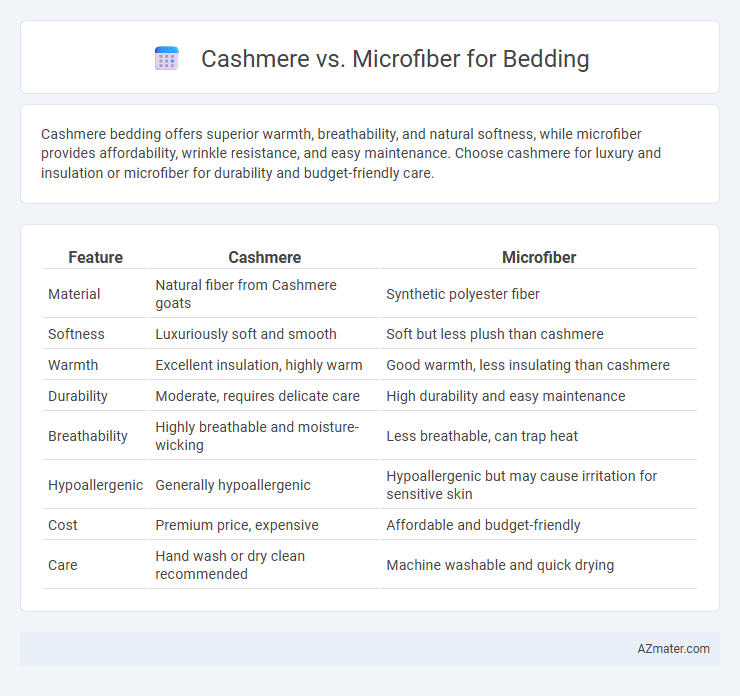Cashmere bedding offers superior warmth, breathability, and natural softness, while microfiber provides affordability, wrinkle resistance, and easy maintenance. Choose cashmere for luxury and insulation or microfiber for durability and budget-friendly care.
Table of Comparison
| Feature | Cashmere | Microfiber |
|---|---|---|
| Material | Natural fiber from Cashmere goats | Synthetic polyester fiber |
| Softness | Luxuriously soft and smooth | Soft but less plush than cashmere |
| Warmth | Excellent insulation, highly warm | Good warmth, less insulating than cashmere |
| Durability | Moderate, requires delicate care | High durability and easy maintenance |
| Breathability | Highly breathable and moisture-wicking | Less breathable, can trap heat |
| Hypoallergenic | Generally hypoallergenic | Hypoallergenic but may cause irritation for sensitive skin |
| Cost | Premium price, expensive | Affordable and budget-friendly |
| Care | Hand wash or dry clean recommended | Machine washable and quick drying |
Introduction to Cashmere and Microfiber Bedding
Cashmere bedding, made from the soft undercoat of cashmere goats, is prized for its luxurious warmth, softness, and natural breathability, making it an ideal choice for cold climates. Microfiber bedding, composed of finely woven synthetic fibers such as polyester, offers exceptional durability, wrinkle resistance, and affordability while maintaining a smooth, lightweight texture. Both materials provide distinct advantages, with cashmere emphasizing natural comfort and luxury, and microfiber excelling in practicality and ease of care.
Material Origins and Composition
Cashmere bedding is crafted from the fine undercoat fibers of cashmere goats, primarily sourced from regions like Mongolia, China, and Nepal, known for their luxurious softness and natural warmth. Microfiber bedding is made from synthetic polyester fibers, engineered through advanced textile processes to mimic the softness of natural fibers while offering durability and stain resistance. The natural origin of cashmere provides superior breathability and insulation, whereas microfiber's synthetic composition allows for easy maintenance and affordability.
Softness and Comfort Comparison
Cashmere offers unparalleled softness and natural breathability, making it exceptionally comfortable for bedding with a luxurious, cozy feel that adapts to body temperature. Microfiber provides a smooth, lightweight texture that retains warmth efficiently while being wrinkle-resistant and hypoallergenic, catering to those seeking easy-care comfort. The choice between cashmere and microfiber depends on preferences for natural fibers versus synthetic durability and maintenance.
Warmth and Temperature Regulation
Cashmere bedding offers superior warmth due to its natural insulating fibers that trap heat while allowing breathability, making it ideal for cold climates. Microfiber bedding provides excellent temperature regulation by wicking moisture away and drying quickly, keeping sleepers cool and comfortable in warmer conditions. Both materials balance warmth and breathability, but cashmere excels in insulation, whereas microfiber is better for controlling humidity and heat.
Durability and Longevity
Cashmere bedding offers exceptional durability due to its natural fibers that resist wear and retain softness over time, typically lasting several years with proper care. Microfiber bedding, made from synthetic fibers like polyester, provides high resistance to stains and wrinkles while maintaining colorfastness, often lasting longer than lower-quality natural fabrics. When considering longevity, cashmere requires delicate maintenance to preserve its luxurious texture, whereas microfiber offers easier care and prolonged durability in everyday use.
Hypoallergenic Properties
Cashmere bedding offers natural hypoallergenic properties due to its fine protein fibers that resist dust mites and allergens, making it ideal for sensitive skin. Microfiber bedding, made from tightly woven synthetic fibers, is also hypoallergenic and resists mold and mildew, promoting a cleaner sleep environment. Both materials provide effective allergen resistance, but cashmere is preferred for natural breathability and moisture-wicking benefits.
Maintenance and Care Requirements
Cashmere bedding requires delicate maintenance, including gentle hand washing or dry cleaning to preserve its softness and prevent damage to the fibers. Microfiber bedding offers easier care with machine-washable durability, stain resistance, and quick drying properties. Choosing between cashmere and microfiber depends on preference for luxury versus low-maintenance convenience.
Price Differences and Affordability
Cashmere bedding commands a premium price due to its luxurious softness and natural insulation, often costing several times more than microfiber options. Microfiber is an affordable alternative, offering durability and easy care without the high cost of natural fibers. Budget-conscious consumers typically choose microfiber for cost-efficiency while those seeking luxury prioritize cashmere despite its higher price point.
Environmental Impact and Sustainability
Cashmere bedding, derived from the soft undercoat of cashmere goats, offers natural biodegradability but often involves high water usage and significant land impact due to grazing, contributing to ecological strain. Microfiber bedding, made from synthetic polyester fibers, typically has a lower immediate resource footprint but raises concerns over microplastic pollution and non-biodegradability. Evaluating environmental impact and sustainability, cashmere supports renewable resources but risks overgrazing, while microfiber challenges include plastic waste and long-term ecosystem effects.
Which Bedding Material Should You Choose?
Cashmere bedding offers superior softness, breathability, and natural insulation, making it ideal for luxurious comfort and temperature regulation. Microfiber bedding provides affordability, durability, and moisture-wicking properties, suitable for easy maintenance and all-season use. Choosing between cashmere and microfiber depends on your preference for high-end softness versus practical, budget-friendly performance.

Infographic: Cashmere vs Microfiber for Bedding
 azmater.com
azmater.com